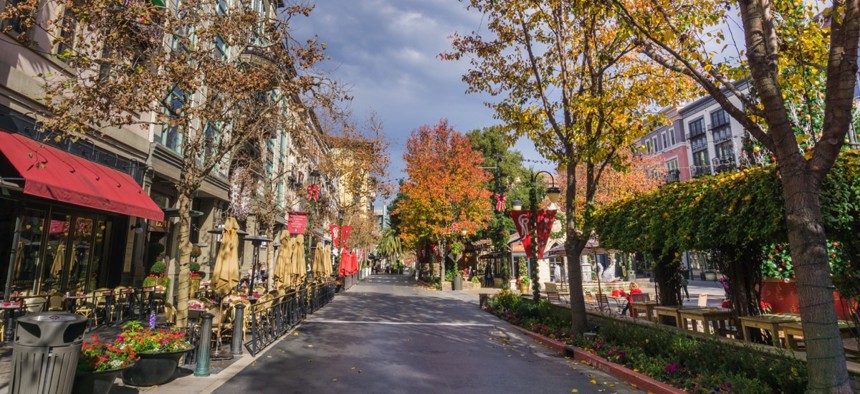Taking City Sustainability to the Next Level

San José, California

Connecting state and local government leaders
“[T]here’s no question we can’t rely on Washington, D.C., to lead if we are going to make any progress toward our climate goals,” San José Mayor Sam Liccardo said.
The city of San José’s Green Vision turns 10 years old in October, leaving the capital of Silicon Valley itching to push the sustainability envelope on energy, mobility and water conservation by engaging local innovators.
The 15-year plan outlines focused objectives to be met by 2022: reducing per capita energy use by 50 percent; receiving all electrical power from clean, renewable sources; diverting all landfill waste to energy; and reusing all wastewater among them.
San José is now developing an Environmental Sustainability Plan inspired by the international Paris Agreement to combat climate change, improving community happiness with traffic and thereby greenhouse gas reductions and California’s extended drought.
“We’re just really launching the public effort now, holding a couple of convenings with sustainability experts to gather both ideas and direction,” Mayor Sam Liccardo told Route Fifty in a phone interview. “We’re fortunate enough be in the heart of Silicon Valley, where we’ve got some of the best minds working with us.”
Liccardo designated $250,000 for the plan last year, the funds coming out of winnings from a Pacific Gas and Electric Company challenge that rewarded community engagement leading to energy efficiency behavioral change. In total, $1.25 million will go toward the plan’s creation and first few years of implementation.
City officials want to make sure any programming that comes out of the plan has resident involvement, so starting in February, San José hired London-based professional services firm PricewaterhouseCoopers to identify sustainability initiatives that would also improve regional quality of life.
“We took a look across the city, region and state at what San José and other organizations had already committed to, to harmonize those,” said Kerrie Romanow, the city’s Environmental Services director. “We needed to understand the lay of the land.”
On Wednesday, the city held an evening meeting to obtain citizen feedback on sustainability they’re interested in.
San José is the largest city in Northern California by population, the third largest in the state and 10th largest in the nation, and was an early U.S. leader in recycling; its waste diversion rate of 74 percent is among the highest in the nation, Romanow said. The city also boasts the second-most per capita solar deployments in California.
This May, members of the City Council will vote on community choice aggregation, the consolidation of energy contracts to purchase the utility as a group rather than individually, which would make San José the largest city with CCA in the nation. Consumers would be able to choose the source of their electricity: PGE or a separate, new aggregator entity with a mandate for a renewable portfolio of likely 50 percent or higher, Liccardo said.
The mayor believes the aggregator can beat the existing utility on price and sustainability, based on the experiences of five other CCAs in operation in counties San José is watching.
“We’re mindful that this is a very uncertain landscape, but there’s no question we can’t rely on Washington D.C. to lead if we are going to make any progress toward our climate goals,” Liccardo said. “That isn’t just the case because Donald Trump is president. Cities have long led the nation in pushing innovation and the envelope on sustainability.”
Romanow is convinced if you can make a sustainability program work in San José, it can be a model for the rest of the country because of the city’s diverse population, which includes Latinos and Asians, and pragmatism. For instance, San José banned single-use plastic bags everywhere, not just grocery stores, to create a citywide habit.
A public survey will go out, likely in late May, further seeking resident feedback on the ESP before coming up with a list of potential programs in “buckets.”
“A lot of the actions are going to be dependent on us securing grants or for-profit or nonprofit funders,” Romanow said. “In the past, if funding became available, we’d work on something.”
Next year’s budget will include funding for a chief sustainability officer.
Liccardo doesn’t see why his city can’t be first for solar installations being located in Silicon Valley and wants to get aggressive with deployment. Smart metering is being rolled out to boost data-driven water conservation.
“In some cases, we have an opportunity to take a pilot in a small town and scale it,” Liccardo said. “In other cases, we’re the one engaging in the pilot ourselves.”
San José is host to the largest dry fermentation anaerobic digestion demo in the world, processing 90,000 tons of commercial organic waste each year.
The city will finalize the ESP most likely in September for a fall vote by Council.
“I definitely think it’s going to be a challenge, but if the plan makes sense, enough organizations throughout the globe are interested in helping to address climate change,” Romanow said. “It’s new for us to seek investment like this.”
Dave Nyczepir is a News Editor at Government Executive’s Route Fifty and is based in Washington, D.C.

NEXT STORY: Building machine parts for intelligence analysts





